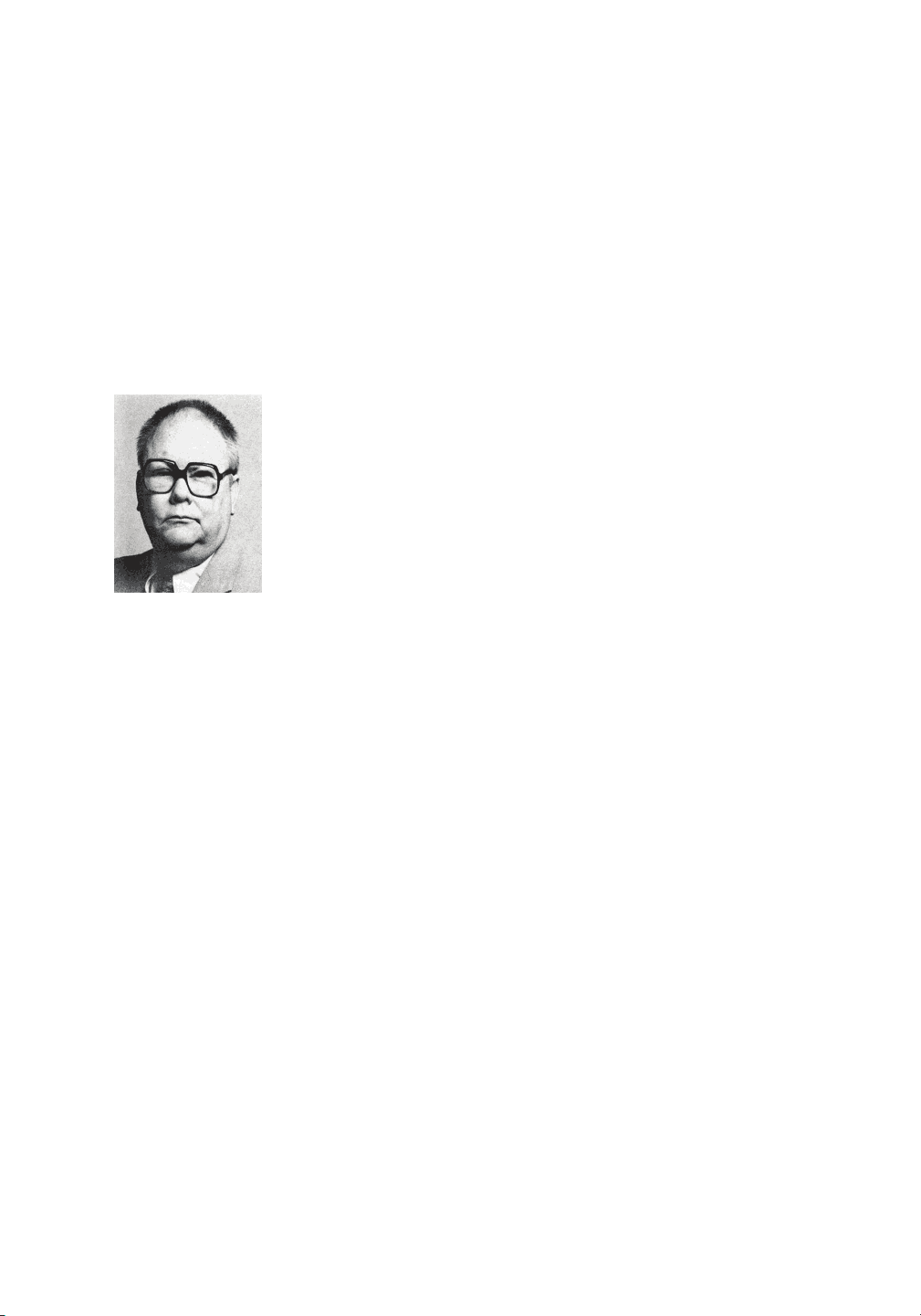
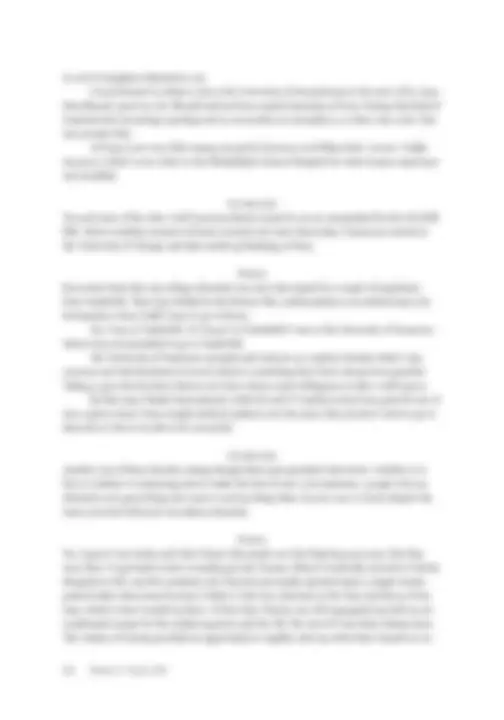

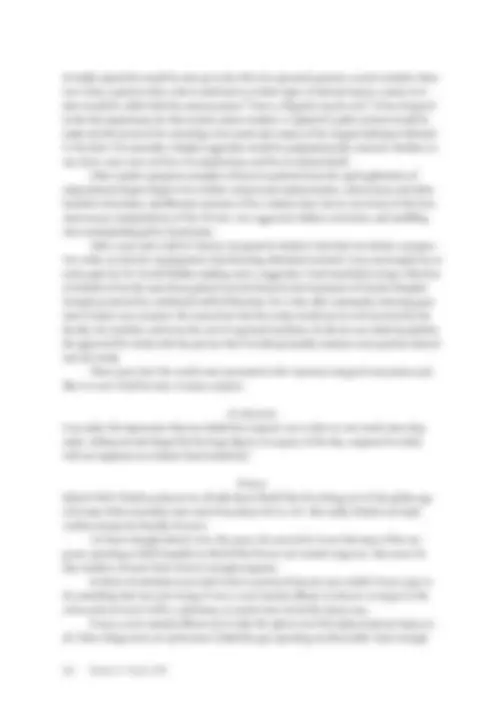
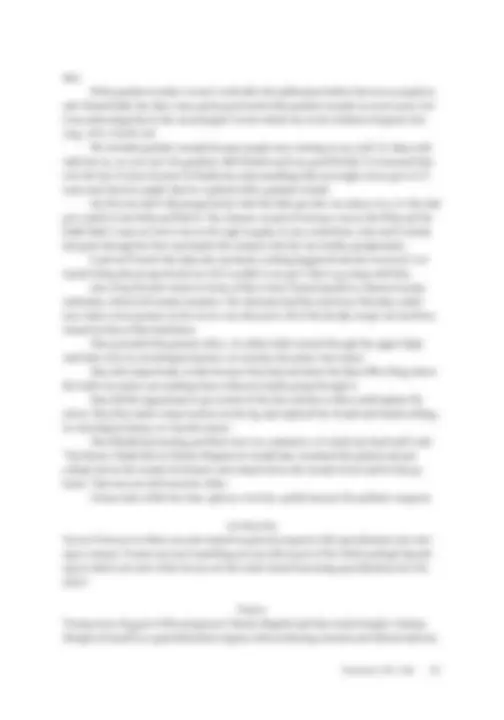
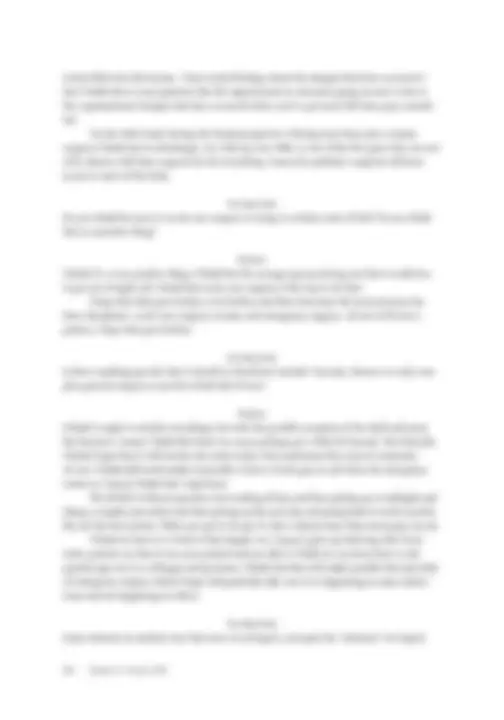



Study with the several resources on Docsity

Earn points by helping other students or get them with a premium plan


Prepare for your exams
Study with the several resources on Docsity

Earn points to download
Earn points by helping other students or get them with a premium plan
Community
Ask the community for help and clear up your study doubts
Discover the best universities in your country according to Docsity users
Free resources
Download our free guides on studying techniques, anxiety management strategies, and thesis advice from Docsity tutors
Dr. David H. Livingston. How and when did you decide upon a career in surgery? When did you decide to be involved in trauma?
Typology: Exams
1 / 11

This page cannot be seen from the preview
Don't miss anything!







280 Francis C. Nance, MD
Dr. David H. Livingston How and when did you decide upon a career in surgery? When did you decide to be involved in trauma?
Dr. Francis C. Nance I always wanted to be a surgeon. My father was a general surgeon and my admiration for him steered me in that direction—I think he had perhaps eight or ten months of surgical training at the public health hospital. He grew up in China and went back to China as a surgeon in Shanghai before the war. He did a lot of surgery under wartime conditions in Shanghai. As you might know, Shanghai was invaded and occupied by the Japanese in 1937 until the end of World War II. He lived and practiced there during that time. He obviously got exposed to a lot of trauma although he was not a trauma surgeon. He got caught by the Japanese and spent four years as a civilian prisoner and operated on about 500 people in a prison camp, keeping people alive. So his surgical training and experience was not classic, and he was almost essentially self-taught with exposure to a few mentors and many patients along the way. When he finally got back from the war, he ended up practicing in Oak Ridge, Tennessee, and that’s where I passed my adolescence. I admired him and it never occurred to me not to want to go into surgery. He grew up in Suzhou and came to the states for college and medical school and always
President 1985–1986 281
planned to go back. He had two brothers and they all wanted to be doctors and decided they would practice in Shanghai. All three of them, headed back and finally got together in the ’30s in Shanghai. Of course the war came along and that ended that. He came back to the states without anything, literally. No savings, no shirt on his back, nothing. The war was still on and he went to Knoxville. He had been there selling Bibles during the summer when he was going to college and liked Knoxville, which turned out not to be a very felicitous place for him. He was occasionally a drinker, actually more than occasion- ally, and Knoxville was a dry town. It was very conservative and he was not. So it was not a happy time. That is how he ended up in Oak Ridge. They needed doctors. When Oak Ridge was still a “secret town,” its medical care was obtained typically by the guy who ran the Manhattan Project. He went to the University of Chicago and drafted half of the faculty saying, “You’re going to an undisclosed location.” At the end of the war, obviously, those guys all wanted out and to go home. That opened spaces the need for doctors and that’s where my dad moved.
Livingston It is obvious that your father’s life experienced made medicine and surgery an obvious path- way. How did you find your way into trauma?
Nance In a very roundabout way. My early interest focused on the physiology and surgery of the GI tract. As a student at the University of Tennessee [UT], I encountered a young academic surgeon, Ed Storer, who was one of the few people trained by the two preeminent GI surgical physiologists of that era: Henry Harkin and Lester Dragstedt. Of course, gastric physiology is dead now. Duodenal ulcers don’t exist anymore, not in the surgery department, at any rate. But back then it was a big deal. I’ve forgotten how I hooked up with him, but I think I was a first- or second-year medical student. He had an ad out looking for a student to work in the lab. I applied for the job and we hit it off so he gave it to me. Storer encouraged me to apply there for a fellowship at UT that would allow me to obtain simultaneous degrees in medicine and physiology, and under his guidance I managed to accomplish that. UT was ideal for that because they were still on their wartime schedule where they started a new class every quarter. So if you started in October, which is what I did, you keep taking a new quarter every quarter. I would have normally finished in December, which is a bad time to look for an internship so I added six months to my total time so that I graduated in June. Well, I went and endowed a little fellowship at UT in his name for students, hoping somebody else would get a chance to do the same thing. Dr. Storer trained at Chicago so I applied there for training. At the University of Chi- cago where I interned, I fully expected to continue my studies in the Dragstedt Lab with his successors. But, the chairman of the department died on my service a month after I started. I didn’t think the department would recover very soon and I was correct. It took them ten years
President 1985–1986 283
idency but I started slowly. When I met with Dr. Cohn for the first time he asked me whether I liked managing burns. After a stammered noncommittal response from me, he announced I would be in charge of the burn service. I soon discovered there was no burn service. Patients were treated with closed bulky dressings on the open un-air-conditioned wards. They were hated by the medical staff and the nurses because the stench of Pseudomonas infections was frequently over-powering. A crash course to self-educate myself ensued which included atten- dance at meetings of the American Burn Association. I became an officer of that organization early on when the Association’s finances were in a desperate state and some enemy of mine suggested my name as a likely and unsuspecting candidate to be treasurer. My first inkling of trouble ahead came when I discovered that dues for the forthcoming year had already been collected and spent. It was a rocky six-year term, but I left the organization in solid financial condition.
Livingston I would think that hardly doing any trauma during training and showing up as an attending at Charity was kind of an interesting baptism.
Nance It was, but it really was a good opportunity. I mean you obviously feel a little naked arriving and realizing that the residents had more experience in treating trauma than you did. But you quickly realized they knew of only one way of treating trauma that had been passed on to them by the chief resident ahead of them who learned from their chief for whoev- er knows how long. They weren’t contaminated or altered very much by the attending staff, at least in trauma. So I had this chance to insist that I participate in all of the patients who came in on my service. I was there. I managed to introduce myself into the practice without getting them mad. Slowly I was able to convince them that there was more than one way to “skin a cat.” It was incredibly helpful to be able to evaluate it from the outside and say, “Why are these guys doing this?” They weren’t asking the questions, so I did. The questions didn’t get answered at conference either because everybody was doing the same thing.
Livingston There is a tremendous value of coming in with a whole fresh perspective and saying, “The emperor has no clothes.”
Nance You’re quoting an editorial of mine. In that dogma-ridden era, virtually every situation had a prescribed solution which was applied diligently. Initially, as a bystander uncontaminated by dogma because of my inexperience, I began to see some of the more egregious faults in the system. One night I discovered an entity known as “the Negative Lap.” Under the protocol that the residents had established over the years, if an abdominal stab wound patient appeared to
284 Francis C. Nance, MD
be badly injured he would be sent up to the OR to be operated upon by a senior resident. How- ever when a patient with a stab wound had no evident signs of internal injury, a junior resi- dent would be called with the announcement “I have a Negative Lap for you”. It was frequent- ly the first laparotomy for that ecstatic junior resident. A xiphoid to pubis incision would be made and the protocol for searching every nook and cranny of the virginal abdomen followed to the letter. Occasionally a helpless appendix would be prophylactically removed. Needless to say, these cases were not free of complications and the occasional death. Other similar egregious examples of harm to patients from the rigid application of unquestioned dogma began to be evident: unnecessary splenectomies, unnecessary and often harmful colostomies, meddlesome invasion of the common duct, heroic resections of the liver, unnecessary manipulations of the GI tract, over-aggressive kidney resections, and meddling into nonexpanding pelvic hematomas. After a year and a half at Charity, I proposed to Isidore Cohn that we initiate a prospec- tive study on selective management of penetrating abdominal wounds. I was encouraged by an early paper by Dr. Gerald Shaftan making such a suggestion. I had marshaled a large collection of statistics from the marvelous patient records housed in the basement of Charity Hospital lovingly protected by a dedicated staff of librarians. Dr. Cohn, after summarily removing gun- shot wounds, was receptive. He warned me that the study would not be well received by the faculty, the residents, and even the rest of organized medicine. In this he was indeed prophetic. He approved the study with the proviso that I would personally examine every patient entered into the study. Three years later the results were presented at the American Surgical Association and, like it or not, I had become a trauma surgeon.
Livingston I am under the impression that you think that surgical care in that era was much more dog- matic, influenced and shaped by the huge figures in surgery of the day, compared to today with an emphasis on evidence based medicine?
Nance Indeed. Well, I think you know we all talk about World War II as being sort of the golden age of trauma where mortality rates went from about 50% to 15%. But really I think it set back civilian trauma for literally 50 years. As I have thought about it over the years, the reason for it was that most of the sur- geons operating in field hospitals in World War II were not trained surgeons. They were 90- day wonders, because there weren’t enough surgeons. In those circumstances you had to have a protocol because you couldn’t trust a guy to do something that was just wrong. It was a court-martial offense to observe an injury in the colon and not treat it with a colostomy, no matter how trivial the injury was. It was a court-martial offense not to take the spleen out if the spleen had any injury at all. Those things were set up because I think the guy operating on them didn’t have enough
286 Francis C. Nance, MD
Livingston With respect to your scientific contributions, I would think that your selective management of penetrating trauma, which you spoke about earlier, is really one that was much ahead of its time. Could you extrapolate a little bit more?
Nance Thank you. I do think that my early work on the selective management of penetrating trauma has profoundly changed the way such patients are managed. First with stab wounds and then extended finally to include gunshot wounds. But it did not come easily. More broadly I think I have served as a general annoyance to those in our profession who substitute dogmatic pro- tocol for individualized treatment. Thinking through a course of management requires more effort, but it’s what doctors are for. I challenged dozens of time-honored but unproved dogmas (all spleens with an injury must be removed all colons with an injury, no matter how trivial in appearance, should treated with colostomy). I wasn’t always alone or even the most important critic, but the effort changed surgical practice. I remember going to one of those conferences were you’ve got a little panel of three or four guys and they were talking about colon injury. One of the guys, who was a past presi- dent of the AAST, and I were there talking about colon injuries. I presented him with various scenarios of injury from minor injuries to ones where the colon that is divided. I could not present a scenario where he would not do a colostomy. The colon has an injury and a little spilled stool. Colostomy. The colon is injured, no spilled stool. Colostomy. I finally got down to a patient having a needle aspiration of the abdomen and the needle went into the colon, no spill. That was a colostomy. We couldn’t agree on that issue. But he was older and senior to me, so I was the guy who got ridiculed.
Livingston How was that accepted when you presented it at the American Surgical?
Nance Not well. If you want to read Carlton Mathewson’s discussion of that paper at the American Surgical, it wasn’t very kind.
Livingston That was a pretty big audience you took on. You presented that what year, sir?
Nance Sixty-eight. The paper came out in 1969 (Ann Surg. 1969;170:569–80). It was a big audience. I was pretty awed by all of the Pooh-Bahs there. It was not well received. I spent probably 25 or 30 years trying to convince people about it. I could go to a conference as a visiting guy and present a theoretical case to the residents and they were going to operate on that patient, even though there were no signs of symptoms of intraperitoneal injuries at least 25 or 30 years after
President 1985–1986 287
that. With gunshot wounds, it wasn’t until after the millennium before that was accepted as safe. Demetriades has done some pretty good work with gunshot wounds in recent years, but I was advocating that in the second paper I wrote which was to the Southern Surgical (Ann Surg. 1974; 179:639–46) We included gunshot wounds because people were starting to say, well, it’s okay with stabs but no, no, you can’t do gunshots. Bill Schwab and I are good friends. I’ve harassed him over the last 10 years because he finally has said something that you might, if you got 14 CT scans and, that you might observe a patient with a gunshot wound. My first one that I did prospectively I had this little gal who was about 18 or 19. She had put a pistol in her belly and fired it. The entrance wound of entrance was in the RUQ and the bullet didn’t come out, but it was in the right scapula. So you could draw a line and it clearly had gone through the liver and maybe the stomach. But she was totally asymptomatic. I said we’ll watch this lady and, you know, nothing happened and she recovered. So I started doing that prospectively too, but I couldn’t even get Cohn to go along with that. One of my favorite stories in terms of this is how I found myself at a famous trauma institution, which will remain nameless. The chairman had this notorious Thursday confer- ence where every patient on the service was discussed. All of the faculty except one had been trained by him at that institution. They presented this patient with a .22 caliber bullet wound through the upper thigh. And there were no neurological injuries, no vascular, the pulses were intact. They did a laparotomy on him because they had read about the blast effect thing where the bullet can injure surrounding tissue without actually going through it. They did the laparotomy to get control of the iliac arteries so they could explore the artery. They then made a large incision on the leg and explored the wound and found nothing, no neurological injury, no vascular injury. They finished presenting and there were no comments, so I raised my hand and I said, “You know, I think that at Charity Hospital we would have examined the patient and put a Band-Aid on the wound of entrance and a Band-Aid on the wound of exit and let him go home.” That was not well received, either. Colons took a little less time; spleens, even less, partly because the pediatric surgeons.
Livingston You are from an era where you just trained as general surgeons with specialization just start- ing to emerge. Trauma was just something you just did as part of the whole package depend- ing on where you were. How do you see the trend toward increasing specialization over the years?
Nance Trauma was a big part of the program at Charity Hospital and that carried weight. I always thought of myself as a gastrointestinal surgeon with continuing research and clinical interests
President 1985–1986 289
Anything you thought was a great idea that didn’t turn out quite the way you hoped?
Nance Total parenteral nutrition, essentially invented at Penn by Rhoads and Stan Dudrick, has not been as important as I once thought it would be. Other methods of feeding with enteral tubes have largely supplanted what seemed to me at the time to be a Nobel Prize-worthy advance.
Livingston What aspects of your career have you found to be the most rewarding?
Nance Teaching residents, particularly at a senior level, has always been my greatest joy and perhaps my best skill. Taking a young surgeon who has acquired most of the basic mechanical skills of the profession through a difficult case, focusing on aspects of care that the resident may not have previously considered, can be deeply rewarding. Raising questions at grand rounds which force a reconsideration of seemingly well-es- tablished protocols of therapy has been a favorite and occasionally productive tool. As an academic surgeon, I greatly valued the opportunity to interact and become friends with my peers at meetings and educational programs.
Livingston What aspects have you found to be the most challenging or difficult?
Nance For me, the administration of a department and the constant need for maintaining discipline were difficult. I found the need for publishing and presenting onerous, partly as a result of a lack of self-discipline. My most recurrent nightmare was going before an audience with an unprepared talk. Failures at the clinical level did not bother me. I am able to learn from errors of judg- ment, make adjustments and go on to the next adventure without dwelling on the past.
Livingston What career advice would you give to young surgeons interested in a career in academic trauma/acute care surgery? What “life-coach” advice would offer them on their lives outside the hospital?
Nance I think surgery is the most satisfying career one can imagine. Surgeons of the future will be better able to rationalize their family commitments and their profession. I am gratified that some modifications in time commitments have occurred, sufficient to begin to attract women into the field. Their greater need for modifications in how a career in surgery is managed have
290 Francis C. Nance, MD
slowly been recognized and (incompletely) implemented.
Livingston What do you perceive as the greatest challenges and opportunities for the future of trauma and ACS?
Nance I worry that we will no longer recruit the best and the brightest into surgery and into trauma surgery specifically. We are losing out to the more lucrative “life-style specialties”—no sick patients, no night call, high reimbursement for brief procedures. I hope we can continue to attract high-quality individuals who are challenged by the difficulty in managing the critically injured.
Livingston What things, if any, would you change related to your professional career?
Nance I wish I had been more successful in persuading my CEO to develop trauma when I moved from LSU to Saint Barnabas Medical Center in New Jersey. Although the burn unit at Saint Barnabas has thrived, I missed the excitement of a busy, trauma-infested emergency room.
Livingston Would you change anything related to your life outside the hospital?
Nance A failing I will always regret was the insufficient time I gave to my family in the early stages of my career. Fortunately, my children and my wife have been remarkably forgiving. I mar- vel at the development of my grandchildren who exhibit changes that I was never able to see when their parents were growing up.
Livingston Are there any parting words of wisdom you would like to leave for this 75th AAST anniversa- ry?
Nance Well, I would only pass on this quote from my mentor Billy Fitts spoken in his unapologetic deep Tennessee twang as we walked into the auditorium while attending my first AAST meet- ing: “Cahtah, this is the greatest organization, ever!” True then, true now.